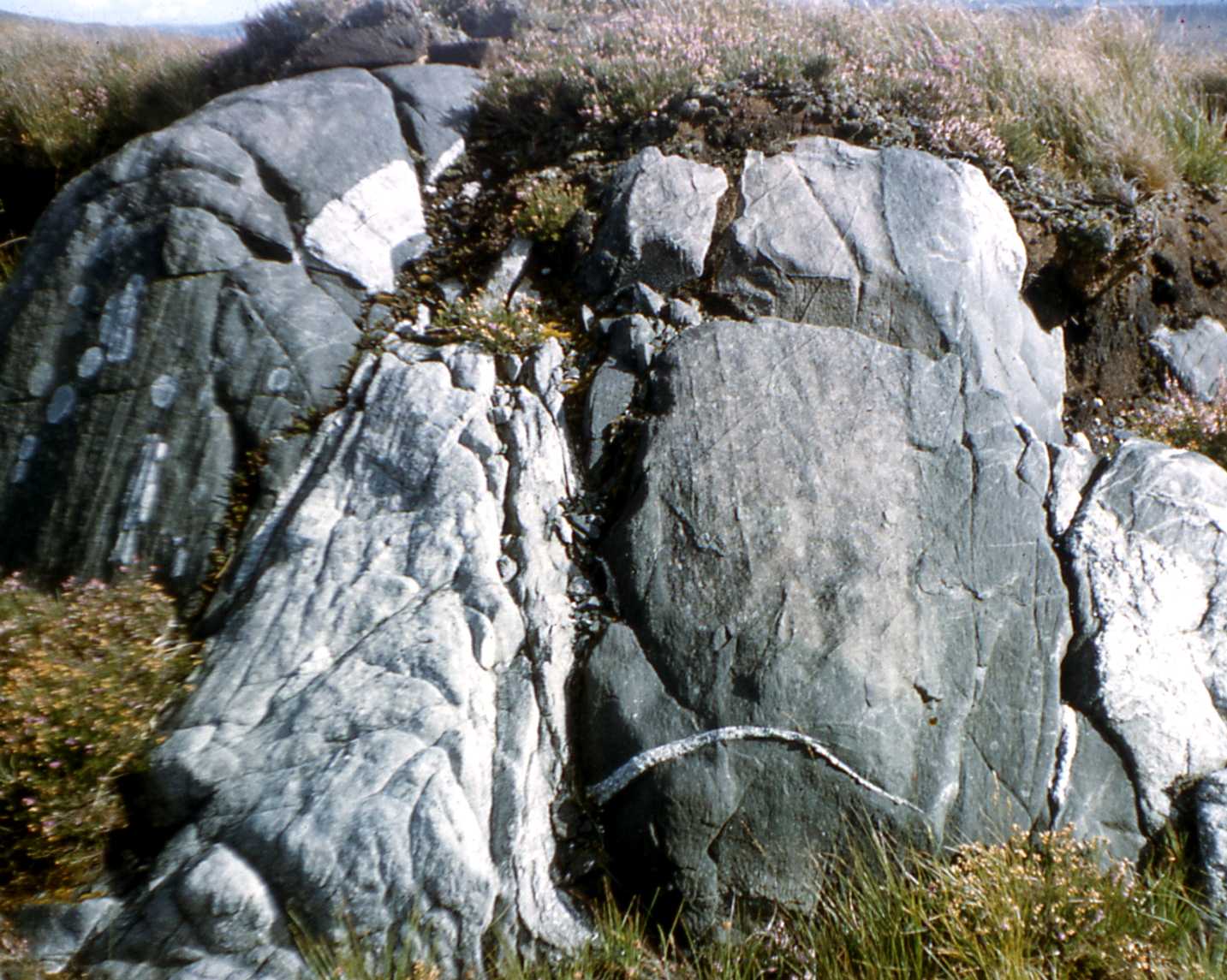
The serendipitous link between Caledonian-Appalachian eclogites and ophiolites
I came to New York in the Fall of 1961 to attend Columbia University as a post-doc to Arie Poldervaart. I had completed a Ph.D. under J.G.C. Anderson, head of the Department of Geology at the University of Wales, Cardiff, and my thesis had been examined by Wally Pitcher of 'Donegal granite' fame. The aim of the study was to determine the structural history of the 'Moinian' rocks of the Ballyshannon region of Southern Donegal, Ireland, according to the methods of structural analysis as they were being practiced by Sutton and Watson, Pitcher, John Ramsay, Tom and Paul Clifford and many others working on the Moine-Dalradian of Scotland. My most interesting discovery in the Irish Moinian was the existence within the polydeformed psammites of metagabbro bodies in various stages of convertion to ecologite/granulite.
Ballyshannon eclogite Betts Cove 'Sheeted diabase' Fleur de Lys eclogite
On arrival in New York I had therefore achieved some degree of expertise in structural analysis, the petrology of eclogites, and the reaction relationships between pegmatites and diopsidic calc-silicate assemblages. Poldervaart was unfortunately very ill while I was at Columbia, but I did manage to a initiate a petrochemical and paleomagnetic study of the eclogites I had brought with me, audit a course, including a field trip to the Adirondacks, offered by Arthur Buddington, begin a study of the polyphase deformation exhibited by the rocks of the Appalachian Susquehanna section near Baltimore, write a chapter on eclogites for a book being edited by Poldervaart, played rugby for Columbia University, and caroused a lot with the late 'Diamond' Vince Manson and 'Ellensburg' Bob Bentley.
During the winter of 1961 Harry Hess came up to Columbia from Princeton to talk about his belief that the sea floor was continually being renewed at mi-ocean ridges, and that consequently there were no very old rocks in the oceans . Other than my recollection that Maurice Ewing, who ran the Lamont-Doherty Geophysical Observatory of Columbia University, was extremely sceptical of Hess' proposition
, I equally short-sightedly didn't see much connection between Hess' ideas and the fact of 'polyphase deformation' in the Caledonides and Appalachians! I also visited the Geophysical Laboratory to talk with Hatton Yoder and Felix Chayes about basalts and eclogites, and it was here that I met Neil Irvine who pointed me towards teaching positions at McMaster University and the University of Western Ontario in Canada. It was at the latter institution I eventually took up a position in 1962 as structural geologist in succession to Visiting Professor Tom Clifford. Paul Clifford got the position at McMaster.In the Spring of 1963 I gave a paper at a conference in Ottawa describing the polyphase nature of the deformation in the Moinian of Donegal, Ireland. At the conference I was fortunate to meet Ward Neale, who pointed out to me that similar deformed psammitic rocks existed in the Burlington Peninsula of northeast Newfoundland (Neale, E. R. W. and Nash, W. A.1963. Sandy Lake (east half) Newfoundland. Geol. Sur. Can. Paper 62-28, p. 40) and that they also might be amenable to structural analysis. Consequently, in the summer of 1963 I travelled to Newfoundland to start a study of the polyphase deformation in the Burlington Peninsula psammites, and with a more distant hope that I might also find eclogites similar to those I had found in the Moinian of Ireland. I didn't find any eclogites in the summer of 1963, but the following year, I found eclogites at four localities along the Westport and Bear Cove roads. These studies led to the introduction of the distinction between high-grade 'orthotectonic' and low-grade 'paratectonic' units in the Caledonian - Appalachian System (Church 1965, 1966) - 'buzz words' I borrowed from de Sitter's book on Structural Geology. ("The style of deformation and the presence of eclogitic rocks in the Fleur de Lys suggests that the latter constitutes a true orthotectonic belt. In contrast the deformation and low grade metamorphism of the rocks of the Baie Verte and Cape St John Groups was produced by an orogenic event which was paratectonic in character.")
Rodgers and Neale (1963) had reinterpreted the Humber Arm Group as two large klippen, thereby bringing to fruition the allochthon concept planted long ago by Logan, and subsequently developed by Ulrich (1902), Ruedeman (1909), Keith (1913), and, in the early 1960's, E-An Zen working in the type area of the Taconic klippen. They drew a detailed stratigraphic and structural analogy between the Newfoundland klippen and the Taconic klippe, and suggested that the Newfoundland klippen were emplaced by gravity sliding from a source to the east of the Long Range. These authors were the first to include the igneous rocks of the Bay of Islands and Hare Bay in the transported rocks, although they assumed that the igneous material intruded the sediments of the Humber Arm, a relationship that had apparently been confirmed by the detailed mapping of Smith (1958).
In 1966 Wilson suggested that the Appalachian/Caledonian system was a suture zone in which a Proto Atlantic ocean was destroyed by continental collision, but, according to Bob Stevens (picture below shows Bob sitting on undeformed shelf carbonates), it was W. (Bill) Fritz of the Geological Survey of Canada who seeded the idea that transport of the Western Newfoundland allochthons was related to the closure of the Proto Atlantic. This suggestion was made in a private discussion after Stevens had given a talk in 1966 to the Logan Club of the Geological Survey of Canada on the geology of west Newfoundland.
At the 1967 Gander Conference, organized by Marshal Kay, Stevens reintroduced Murray's use of the term "ophiolite" for the Hare Bay and Bay of Islands Igneous Complexes but with no genetic implication. At the same Conference I once again, emphasizing the eclogite link, attempted to justify "a correlation of the Fleur de Lys metamorphism and tectonism with that of the Penobscot Disturbance of Maine and the Moine-Dalradian of the British Isles, thus supporting the concept of Continental Drift."
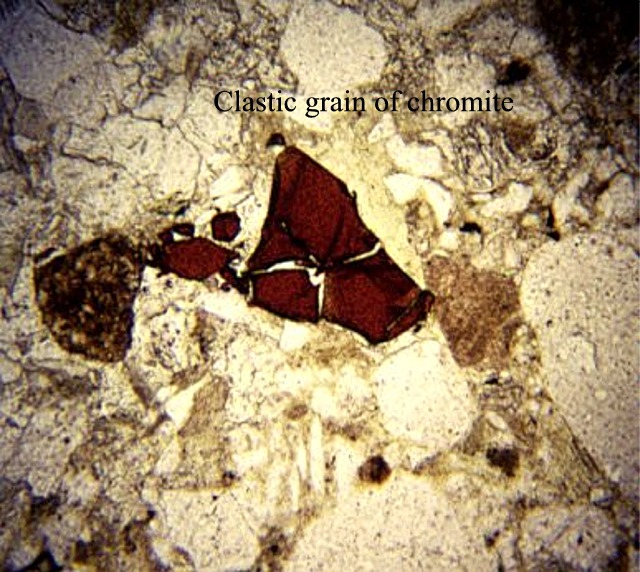 By 1967
Stevens had
noted the
presence of detrital chromite in quartzo-feldspathic (including
K-feldspar) Arenig flysch of Western Newfoundland, on which basis I looked for
and found detrital
chromite in sediments associated with an east-facing ophiolitic sequences
located to the east of the high grade metamorphic belt (Fleur de Lys Supergroup)
of the Burlington Peninsula. This led us to propose ( 'Crustal Evolution of
the Western Margin of the Newfoundland Appalachians', Ann. Meet. Geol. Soc. Am,
1968, p. 53-54) that
"The Taconic (Caradoc) klippen of Western Newfoundland are composite thrust sheets.
Thick ophiolite units structurally overlie allochthonous Cambro-Ordovician
clastic sediments which include Arenig flysch with fragments of serpentinite and
grains of chromite." In other words the allochthonous flysch sediments were
originally laid
down as a carpet in front of the over-riding "allochthonous ophiolites"
and their substrate of Cambro-early Ordovician continental margin deposits. We
knew therefore that the ophiolites were allochthonous relative to the underlying sediments, which
were themselves allochthonous relative to the underlying rift margin sequence, and that they both came from the East; but we
didn't know that the easterly source of the ophiolites was the Prot-Atlantic
ocean. We also surmised that the "The segment of crust on which the
allochthonous sediments were laid seems to have been lost along the Cabot fault
zone". .
By 1967
Stevens had
noted the
presence of detrital chromite in quartzo-feldspathic (including
K-feldspar) Arenig flysch of Western Newfoundland, on which basis I looked for
and found detrital
chromite in sediments associated with an east-facing ophiolitic sequences
located to the east of the high grade metamorphic belt (Fleur de Lys Supergroup)
of the Burlington Peninsula. This led us to propose ( 'Crustal Evolution of
the Western Margin of the Newfoundland Appalachians', Ann. Meet. Geol. Soc. Am,
1968, p. 53-54) that
"The Taconic (Caradoc) klippen of Western Newfoundland are composite thrust sheets.
Thick ophiolite units structurally overlie allochthonous Cambro-Ordovician
clastic sediments which include Arenig flysch with fragments of serpentinite and
grains of chromite." In other words the allochthonous flysch sediments were
originally laid
down as a carpet in front of the over-riding "allochthonous ophiolites"
and their substrate of Cambro-early Ordovician continental margin deposits. We
knew therefore that the ophiolites were allochthonous relative to the underlying sediments, which
were themselves allochthonous relative to the underlying rift margin sequence, and that they both came from the East; but we
didn't know that the easterly source of the ophiolites was the Prot-Atlantic
ocean. We also surmised that the "The segment of crust on which the
allochthonous sediments were laid seems to have been lost along the Cabot fault
zone". .
In 1968 I met Hugh Davies at the Prague IGCP where we discussed his idea that the allochthonous ophiolites of Papua - New Guinea represented displaced samples of Pacific ocean crust and that the same idea might apply to the Bay of Islands ophiolite, and that same year Ian Gass' paper 'Is the Troodos Massif of Cyprus a fragment of Mesozoic oceanic floor' appeared in Nature. Neither paper contained or tried to mount a persuasive argument in favour of their formation by 'spreading' at an oceanic ridge.
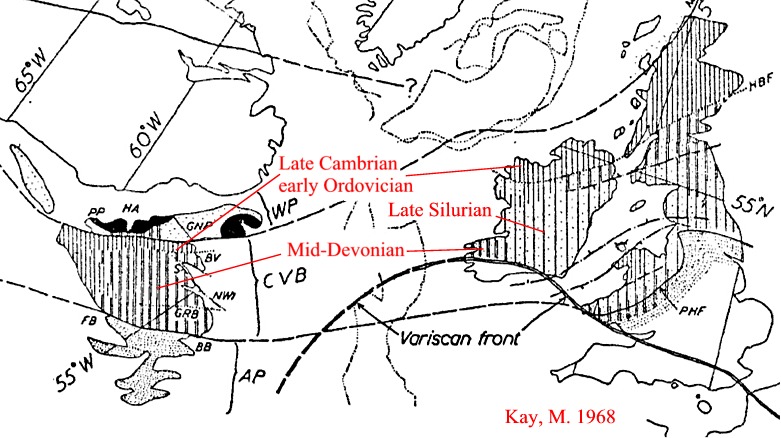 There
was little interest in the 'eclogite link'. For
example, in
early 1968 following the 1967 Gander Conference, Marshall Kay (Kay, M., 1968. North
Atlantic Continental Drift. Symposium on "Gondwanaland Revisited", Proc. Am.
Phil. Soc., 112, 5, p. 321. Read April 19 1968) published a map showing
the Fleur de Lys and
Moine Dalradian as contiguous belts labelled "Late Cambrian early Ordovician
deformation." The text states: "On the west in a limited area in the Burlington
Peninsula are metamorphic rocks that may be late Precambrian and Cambrian (Neale
and Kennedy, 1967), forming an orthotectonic zone."
Equally, Dewey, J. and Kay, M. (1968. Appalachian and Caledonian evidence for drift in the
North Atlantic. Princeton University Press.) use the give-away buzz
words without giving the source of their reflections: "In the Caledonian mobile belt,
opposing margins of quite different character reflect the asymmetry of the belt
and divisibility into an early northern orthotectonic belt involving late
Proterozoic and Cambrian strata deformed during Late Cambrian or Early
Ordovician times and a later southern paratectonic belt in which Cambrian,
Ordovician and Silurian sequences suffered a climactic deformation in Late
Silurian times. The northern orthotectonic belt shows great strike persistence
in stratigraphic sequence, particularly in the Dalradian, which may be compared
with the Fleur de Lys Group of Newfoundland."
There
was little interest in the 'eclogite link'. For
example, in
early 1968 following the 1967 Gander Conference, Marshall Kay (Kay, M., 1968. North
Atlantic Continental Drift. Symposium on "Gondwanaland Revisited", Proc. Am.
Phil. Soc., 112, 5, p. 321. Read April 19 1968) published a map showing
the Fleur de Lys and
Moine Dalradian as contiguous belts labelled "Late Cambrian early Ordovician
deformation." The text states: "On the west in a limited area in the Burlington
Peninsula are metamorphic rocks that may be late Precambrian and Cambrian (Neale
and Kennedy, 1967), forming an orthotectonic zone."
Equally, Dewey, J. and Kay, M. (1968. Appalachian and Caledonian evidence for drift in the
North Atlantic. Princeton University Press.) use the give-away buzz
words without giving the source of their reflections: "In the Caledonian mobile belt,
opposing margins of quite different character reflect the asymmetry of the belt
and divisibility into an early northern orthotectonic belt involving late
Proterozoic and Cambrian strata deformed during Late Cambrian or Early
Ordovician times and a later southern paratectonic belt in which Cambrian,
Ordovician and Silurian sequences suffered a climactic deformation in Late
Silurian times. The northern orthotectonic belt shows great strike persistence
in stratigraphic sequence, particularly in the Dalradian, which may be compared
with the Fleur de Lys Group of Newfoundland."
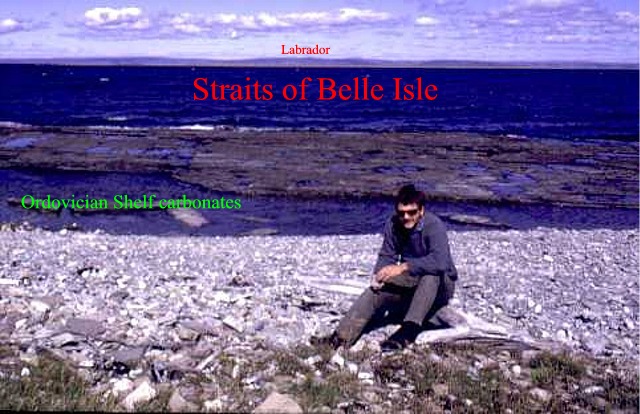 Italian journals for articles on eclogites. In the Spring of 1969 I struck
lucky, not with respect to eclogites as it turned out, but because the Swiss
journal Schweizerische Petrologische Mineralogische Mitteilung published in
February of that year a paper by Ben Reinhardt on the
oceanic nature of the Oman ophiolite. Reinhardt
described 'sheeted diabases' as a distinctive unit within the ophiolite, and
explained their formation in the context of the tensile steady-state formation
of oceanic crust. This was the first major geologic contribution (as distinct
from a geophysics contribution) to our understanding of the mechanism of sea-floor spreading. The
importance of this paper has been considerably underestimated. An abstract
was sent off for presentation at the Fall meeting of the Geol Soc. America in
Atlantic City (Age of Ultramafic rocks in the North-Western Appalachians' in
which Stevens and I concluded that "The large amount of ultramafic detritus in the Lower and Middle Ordovician
sediments of Quebec and Newfoundland indicated that the ultramafic rocks exposed
at present are mere remnants of a much larger sheet, perhaps comparable to those
of the Circum-Pacific belt or the Oman." The paper was not
however presented as such because in the summer of that same year, Bob Stevens
and I started mapping along the east coast of the Burlington Peninsula, and saw
for the first time the spectacular 'sheeted diabase' unit of the Betts Cove
ophiolite. With the knowledge gained from Reinhardt's paper we immediately
understood that the ophiolites of Newfoundland indeed
represented oceanic crust formed at a ridge within Wilson's Proto-Atlantic ocean. The
allochthonous and oceanic origin of the Newfoundland ophiolites thus became
fixed as a point of reference for all future tectonic studies of the
Appalachians.
Italian journals for articles on eclogites. In the Spring of 1969 I struck
lucky, not with respect to eclogites as it turned out, but because the Swiss
journal Schweizerische Petrologische Mineralogische Mitteilung published in
February of that year a paper by Ben Reinhardt on the
oceanic nature of the Oman ophiolite. Reinhardt
described 'sheeted diabases' as a distinctive unit within the ophiolite, and
explained their formation in the context of the tensile steady-state formation
of oceanic crust. This was the first major geologic contribution (as distinct
from a geophysics contribution) to our understanding of the mechanism of sea-floor spreading. The
importance of this paper has been considerably underestimated. An abstract
was sent off for presentation at the Fall meeting of the Geol Soc. America in
Atlantic City (Age of Ultramafic rocks in the North-Western Appalachians' in
which Stevens and I concluded that "The large amount of ultramafic detritus in the Lower and Middle Ordovician
sediments of Quebec and Newfoundland indicated that the ultramafic rocks exposed
at present are mere remnants of a much larger sheet, perhaps comparable to those
of the Circum-Pacific belt or the Oman." The paper was not
however presented as such because in the summer of that same year, Bob Stevens
and I started mapping along the east coast of the Burlington Peninsula, and saw
for the first time the spectacular 'sheeted diabase' unit of the Betts Cove
ophiolite. With the knowledge gained from Reinhardt's paper we immediately
understood that the ophiolites of Newfoundland indeed
represented oceanic crust formed at a ridge within Wilson's Proto-Atlantic ocean. The
allochthonous and oceanic origin of the Newfoundland ophiolites thus became
fixed as a point of reference for all future tectonic studies of the
Appalachians.
Confirmation of the Betts Cove observation was provided in the same year by Fergus Graham (later chief geologist with BP) in his exploration report for Long Lac Gold Mines ( "....the lower part examined consists almost entirely of a complex series of thin sills with few interstratified volcanics. In the upper part the sills gradually become less numerous....these rocks display a sharply layered appearance with a fairly constant dip and strike. Contacts between the sills are often extremely sharp and cross cutting relationships occur." ) These observations clearly confirmed that "sheeted diabases" were also present in the Blow Me Down ophiolite of Western Newfoundland.
The discovery of "sheeted diabase"
unit in the Newfoundland ophiolites was reported at the Atlantic City GSA meeting in the Fall of 1969 and
at the
International Symposium on Mechanical
 Properties and Processes in the Mantle,
Flagstaff, Arizona, 24 June - 3 July, 1970. Stevens also incorporated the
finding into his representation (1970) of the Bay of Islands ophiolite of
Western Newfoundland as a thrust sheet of oceanic crust in his seminal paper,
presented at the GAC Annual Meeting in Montreal in 1969, on
the "Cambro-Ordovician flysch sedimentation and tectonics in west Newfoundland
and their possible bearing on a proto-Atlantic Ocean ". John Dewey's paper in
Nature linking the evolution of the Caledonian-Appalachian system to a plate
tectonic schema also appeared in 1969, but is not referenced in Steven's 1970 paper
(submitted 1969), nor even by Dewey and Bird (1971; submitted in December 1970).
Clearly therefore Dewey's paper in terms of ideas linking Appalachian geology to
plate tectonics provided no impetus over that already provided by Wilson and
Fritz, and with regard to the interpretation of the role of ophiolites in the
plate tectonic interpretation of the Appalachians the explanation presented by Dewey,
and Bird and Dewy was quite different from the obduction model we espoused.
Properties and Processes in the Mantle,
Flagstaff, Arizona, 24 June - 3 July, 1970. Stevens also incorporated the
finding into his representation (1970) of the Bay of Islands ophiolite of
Western Newfoundland as a thrust sheet of oceanic crust in his seminal paper,
presented at the GAC Annual Meeting in Montreal in 1969, on
the "Cambro-Ordovician flysch sedimentation and tectonics in west Newfoundland
and their possible bearing on a proto-Atlantic Ocean ". John Dewey's paper in
Nature linking the evolution of the Caledonian-Appalachian system to a plate
tectonic schema also appeared in 1969, but is not referenced in Steven's 1970 paper
(submitted 1969), nor even by Dewey and Bird (1971; submitted in December 1970).
Clearly therefore Dewey's paper in terms of ideas linking Appalachian geology to
plate tectonics provided no impetus over that already provided by Wilson and
Fritz, and with regard to the interpretation of the role of ophiolites in the
plate tectonic interpretation of the Appalachians the explanation presented by Dewey,
and Bird and Dewy was quite different from the obduction model we espoused.
We were also impressed by the dynamothermal aureoles associated with the Western Newfoundland and Baie Verte ophiolite , and consequently proposed (Church and Stevens, 1970) that the ophiolites may have been emplaced directly onto the Fleur de Lys metamorphic rocks of the continental margin, immediately following the inception an an ocean-forming ridge within the sialic basement of the Appalachian-Caledonian geosyncline, or, alternatively, that the ophiolites may have been emplaced during the closing of the Appalachian ocean while the ridge was positioned close to the continental margin or was newly developing within the margin, a view I later (1973) adapted in explanation of the Ballantrae ophiolite of Scotland - "The existence of high temperature aureoles implies that that the time of their emplacement were relatively hot and that the age of the ophiolites should not differ greatly from that of their emplacement. It also follows that the place of origin of the ophiolites should be a site of high heat flow and thin lithosphere located relatively near the zone of emplacement"; "The glaucophane at Ballantrae may ...have developed along a thrust, within the lower part of the basal ganulite-amphibolite-greenschist 'aureole', during a period of 'cold' thrusting later than the primary emplacement of the ophiolite and formation of the basal amphibolite." It was also pointed out that "it seems likely that a period of subduction followed obduction of oceanic crust, since the the ophiolites are overlain by arc-type volcanic rocks which are in part younger than sediments containing debris derived from the ophiolite."
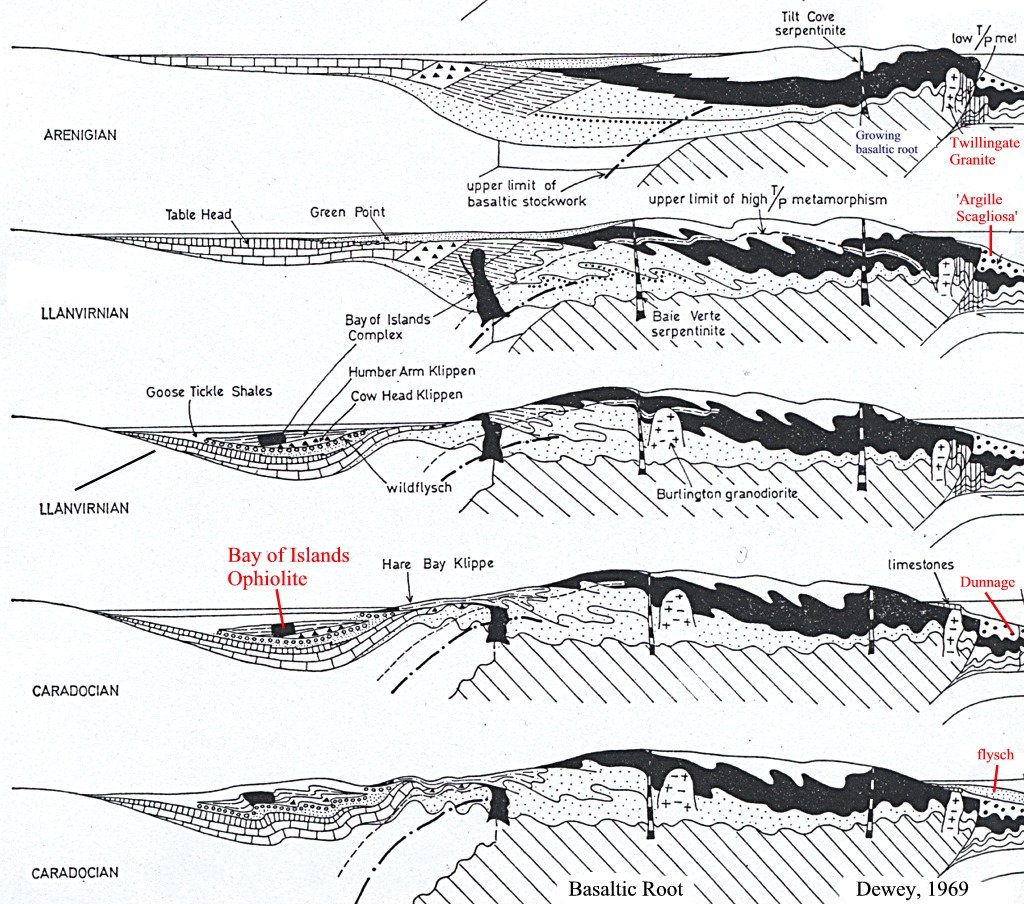 The oceanic spreading centre interpretation
for ophiolites contrasted with that of Bird and Dewey (1970) who held that the
Bay of Islands ophiolite' were intrusive igneous bodies derived as diapirs from
a subduction zone, a view that was retained by other British workers such as
Baker (1973) and Maltman (1975) in the case
of the ophiolites of Anglesey. A second point of difference concerned the polarity of subduction. According to Dewey (1969) and Bird and Dewey (1970) subduction was
directed in a generally western direction, that is under the North American
continent so that the ancient continental margin would have had the character of
an Andean mountain range.
The oceanic spreading centre interpretation
for ophiolites contrasted with that of Bird and Dewey (1970) who held that the
Bay of Islands ophiolite' were intrusive igneous bodies derived as diapirs from
a subduction zone, a view that was retained by other British workers such as
Baker (1973) and Maltman (1975) in the case
of the ophiolites of Anglesey. A second point of difference concerned the polarity of subduction. According to Dewey (1969) and Bird and Dewey (1970) subduction was
directed in a generally western direction, that is under the North American
continent so that the ancient continental margin would have had the character of
an Andean mountain range.
The Newfoundland scenario was extended to the Quebec Appalachians at the symposium 'The ancient oceanic lithosphere' held at Carleton University, Ottawa, in October 1970, at which time the consensus view in Quebec (e.g. Lamarche, 1972) was that the ophiolites of the Sherbrooke area were formed as massive sea-floor volcanic extrusions - the classic 'epanchements sous-marins' of Routhier and his co-workers Brun and Dubertret.
By late 1971, Dewey and Bird (1971; and Bird, Dewey, and Kidd (1971) ) had accepted our interpretation of the
formation and emplacement of the Western Newfoundland ophiolites but suggested that they formed in a small ocean basin above a west dipping subduction zone.Later workers (Williams, 1971, 1972; Upadyhay et al, 1971; Williams and Malpas. 1972, dikes and breccias; Williams and Smyth. 1973; Norman and Strong, 1975; and Riccio, 1976) have substantially supported the concept of an oceanic origin of the Newfoundland ophiolites, and it is now also generally accepted that the sedimentary rocks of west Newfoundland represent a telescoped continental margin of Cambro-Ordovician age, and that the sedimentary and tectonic evolution of the region is related to a cycle of birth and destruction of an Early Paleozoic ocean.
In 1973 Church and Gayer suggested that in
the case of the Caledonian Ballantrae ophiolite of southern Scotland, its northwesterly obduction was
succeeded by a flip in the direction of
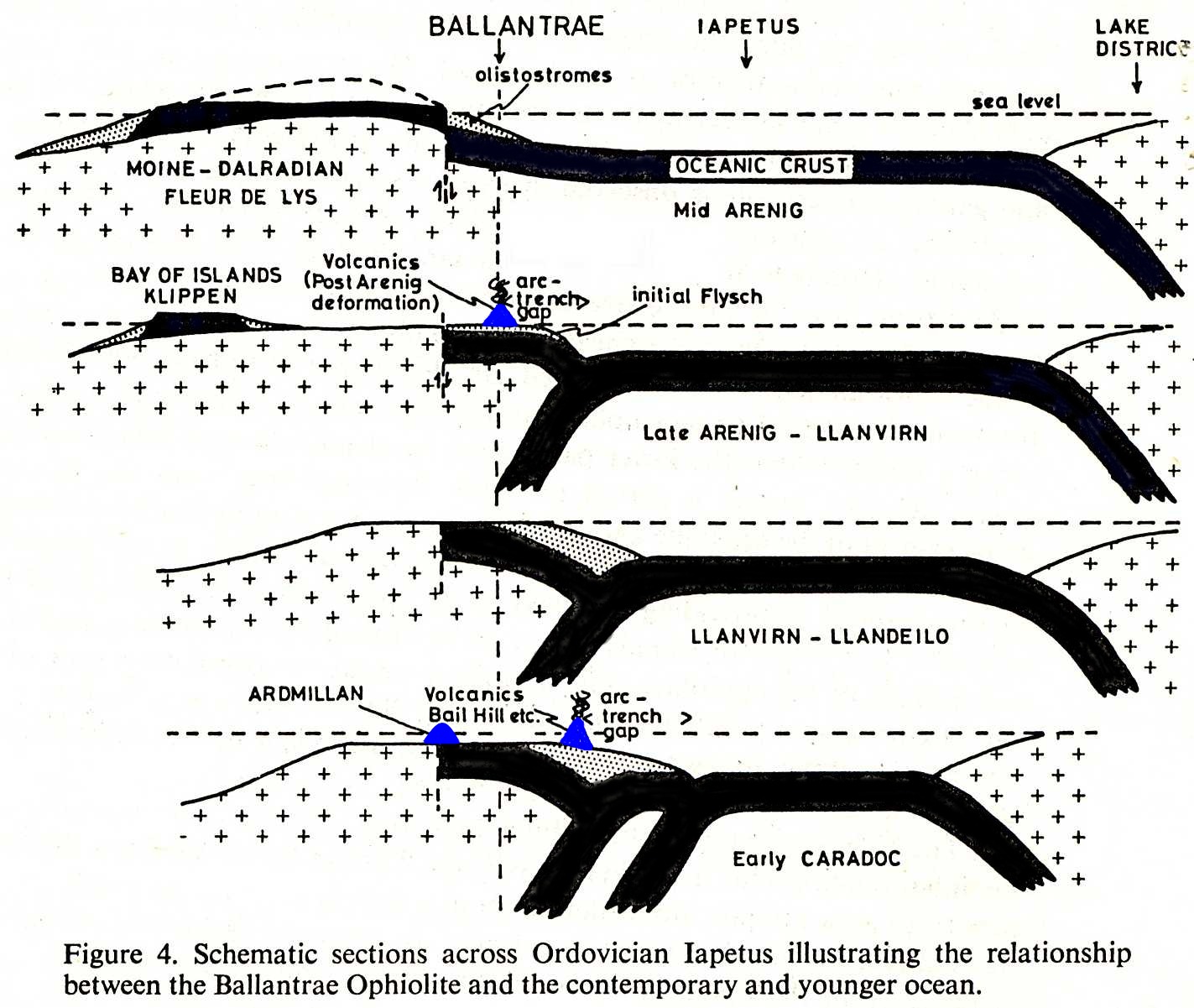 subduction
from SE to NW, the ophiolites
being
overlain by arc-type volcanic rocks which are in part younger than sediments
containing debris derived from the ophiolite." (See also Draut and
Clift, 2002 and Kim, Coish,
Evans and Dick 2003. Supra-subduction zone extensional magmatism in Vermont and
adjacent Quebec: implications for early Paleozoic Appalachian tectonics. BGSA,
115, p. 1552-1569.) They also proposed that the
Proto-Atlantic suture "separating the Ordovician plates should lie in the
vicinity of the Solway Firth (Fig 3)." ,and that the Proto-Atlantic suture in
Newfoundland separated the Exploits Zone from the Caldwell - Fleur de Lys
orthotectonic zone (Dunnage Zone of Williams).
subduction
from SE to NW, the ophiolites
being
overlain by arc-type volcanic rocks which are in part younger than sediments
containing debris derived from the ophiolite." (See also Draut and
Clift, 2002 and Kim, Coish,
Evans and Dick 2003. Supra-subduction zone extensional magmatism in Vermont and
adjacent Quebec: implications for early Paleozoic Appalachian tectonics. BGSA,
115, p. 1552-1569.) They also proposed that the
Proto-Atlantic suture "separating the Ordovician plates should lie in the
vicinity of the Solway Firth (Fig 3)." ,and that the Proto-Atlantic suture in
Newfoundland separated the Exploits Zone from the Caldwell - Fleur de Lys
orthotectonic zone (Dunnage Zone of Williams).
In 1973 Miyashiro published his controversial paper 'The Troodos ophiolitic complex was formed in an island arc.' , in which he argued that the chemical character of the Troodos ophiolite indicated that it formed in a magma chamber located within an island arc. No recognition was given to the significance of the sheeted dike unit in the Troodos complex, and Miyashiro's claim was clearly a reversion to the earlier ideas of Dewey, Bird, Baker, and Maltman. However in the same year a sheeted diabase unit was found in the Bou Azzer ophiolite complex of the El Graara inlier, Marocco (Church and Young, 1974).
Workers in Quebec (St. Julien, P. and Hubert, C. 1975. Evolution of the Taconian Orogen in the Quebec Appalachians. American Jour. Sci., 275-A, p.337-362) also slowly adopted the 'ocean crust' interpretation. Reluctantly however, since although St. Julien and Hubert (1975) did reference Stevens' 1969 ophiolite obduction emplacement paper they only commented on his views concerning the presence of wildflysch units associated with the Taconic klippen in Western Newfoundland; no attribution was gven to the far more important proposal concerning ophiolites as oceanic crust, or the obduction relationship of the klippen to the ophiolites. In fact the idea that the ophiolites were of oceanic origin was attributed by St-Julien and Hubert to Laval geologist Roger Laurent (1973). Nor were the lateral correlations between Newfoundland and Quebec along the length of the Appalachians embraced at this time by New England-Quebec workers.
In 1976 Ray Coish and I published a rationalization of Miyashiro's chemical observations concerning Troodos, pointing out that the arc-like TiO2 characteristics of Troodos were shared by the adjacent Baer Bassit ophiolite of Syria and the internal zone ophiolites of the Newfoundland Appalachians, but that in all cases the internal stratigraphy of these ophiolites clearly favoured their formation by crustal spreading and not by intrusion into an arc complex. In 1977 Riccio and I devised a general classification for Appalachian ophiolites based on the variation in the nature of cumulate sequence in ophiolites. Ray Coish (Coish and Church, 1979) showed how the arc-like Ti-depleted character of the ophiolites of the Appalachian internal belt in Newfoundland and Quebec - as well as some dikes of the Bay of Islands ophiolite - was also reflected in the REE patterns of basaltic rocks. In 1982 boninites were found to characterise the fore-arc basement of the Mariana arc, and their chemical character as determined by Hickey and Frey (1982) allowed the low-Ti, olivine-orthopyroxene cumulates type internal zone ophiolites to be characterized as fore-arc 'boninitic' complexes (Coish, Hickey and Frey, 1982). Later they would come to be known as supra-subduction zone ophiolite complexes. (Pearce, Lippard, and Roberts, 1984), and as such were related to back-arc spreading processes.
The identity of the Quebec internal zones ophiolites with those of the Newfoundland Appalachians was restated in 1977, and the internal ophiolite zone front extending from Newfoundland to Quebec was defined as the 'Asbestos Line'. The Proto-Atlantic suture was shown to follow the boundary between the Caldwell - Fleur de Lys orthotectonic zone and the Tetagouche - Expoits volcanic zone, following the Victoria Lake - Dunnage fault in Central Newfoundland. In this respect the Fleur de Lys orthotectonic zone was considered to extend beneath the internal zone ophiolite belt out to at least the suture boundary. This contrasts with the scenario later advanced by Williams and St Julien (1982), where this boundary was postulated to represent the actual suture interface of the Appalachian continental and oceanic domains.
In 1977 Bill Kidd made the case for the ophiolites representing an arc-related small Ordovician marginal basin (Kidd, W.S.F. 1977. The Baie Verte Lineament, Newfoundland: ophiolite complex floor and mafic volcanic fill or a small Ordovician marginal basin. p 407-418 in Talwani, M., and Pitman, W., eds., Island arcs, deep-sea trenches, and back-arc basins. Am. Geoph. Union, Maurice Ewing series, v. 1.) Important observations made by Kidd concerning the Baie Verte olistostrome above the ophiolite at the base of the Baie Verte arc volcanic sequence included: "Other rare clasts within the conglomerate include pieces of silicic tuff with a strong pre-depositional foliation; these range in size from pebbles to a slab 1 metre across." "Also matchable with the Grand Cove rocks to the east is one large block (1x2 metres exposed) of silicic meta-siltstone possessing a well-developed pre-depositional muscovite schistosity axial surface to tight folds, both refolded by open angular folds that are also predepositional."
The 'back-arc theme was also taken up by Upadhyay, H.D. and Neale, E.R.W. (1979. On the tectonic regimes of ophiolite genesis. Earth Planetary Sc. Letters, 43, 93-102.)
In 1983 Jim Hibbard published his monumental Memoir and map for the geology of the Burlington Peninsula (Hibbard, J. 1983. Geology of the Baie Verte Peninsula, Newfoundland. Dept of Mines and Energy, Government of Newfoundland and Labrador, Memoir 2, 279 p.). The memoir includes a thorough historiographic review of the evolution of ideas concerning the geological evolution of the Burlington Peninsula.
In 1987 I suggested that Appalachian ophiolites represent fore-arc rather than back-arc spreading centres as was the then popular view - " A new approach would be to consider the Thetford ophiolite as having formed in a fore-arc spreading centre environment, as envisioned by Pearce, Lippard, and Roberts (1984), tectonically transported by strike-slip faulting as a fore-arc sliver." "low Ti complexes such as Thetford, Betts Cove, and Cyprus represent incipient or active spreading centres formed within fore-arc strike-slip zones in response to rapid oblique subduction. The strike-slip faulting was also responsible for the separation of the slivers from the developing arc as well as their lateral transportation to a location perhaps distant from their place of origin." " ..even the Coastal complex of western Newfoundland, rather than having formed within a ridge transform as supposed by Karson et al (1983) may represent an incipient spreading centre of Betts Cove type developed within a strike-slip fault zone." "The red argillites could post-date entirely the cessation of attempted subduction of the supposed slope and rise sediments of the Caldwell Group in a progressively widening basin to the rear of the obducted ophiolite prior to the initiation of Ascot-Weedon arc volcanism ( = Burlington magmatism in Newfoundland) in response to a switch in subduction polarity."
ECLOGITES - THE CYCLE COMPLETED
Recent work on the ophiolites of Oman and Papua - New Guinea has emphasized the close temporal relationship of the ophiolites, their dynamothermal aureoles, and the eclogite-bearing 'spot' crustal extrusion zones located to the rear of the obducted ophiolite plate (FERNANDO MARTINEZ, ANDREW M. GOODLIFFE & BRIAN TAYLOR, 2001. Metamorphic core complex formation by density inversion and lower-crust extrusion. Nature, 411, p.930 - 934) - the Saih Hatat extensional window (lower plate) of the Oman (Warren, Clare, Randall R. Parrish, David J. Waters and Michael P. Searle . 2005 Dating the geologic history of Omanís Semail ophiolite: insights from U-Pb geochronology. Contr. Min Pet 150, 4, 403-442) and the d'Entrecasteaux islands in the case of Papua - New Guinea (Suzanne L. Baldwin, Brian D. Monteleone, Laura E. Webb, Paul G. Fitzgerald, Marty Grove & E. June Hill, 2004, Pliocene eclogite exhumation at plate tectonic rates in eastern Papua New Guinea. Nature, Sept, v. 431, p. 263-267). Dating of the ophiolites, their dynamothermal aureoles, and the exhumed eclogites has shown that the ophiolites were tectonically emplaced shortly after their formation, thus confirming the earlier contention of Church and Stevens (1970) that the ophiolites may have been "emplaced during the closing of the Appalachian ocean, while the ridge was positioned close to the continental margin or was newly developing within the margin." Whether the eclogite-bearing Fleur de Lys and Ox Mountain/Lough Derg rocks, and the Belvedere Mountain (Vermont) terrain represent "spot extensions", or whether they are related to periods of more generalized late Taconic or Siluro-Devonian extension and exhumation, remains yet to be argued. The association of Late Proterozoic - Cambrian ophiolite, blueschist, and foreland?/molasse? basin deposits on Anglesey, Wales, poses a similar problem. Age relationships and sedimentary facies reconstructions in Anglesey suggest that the blueschists there could
also represent a spot extrusion through an easterly obducted ophiolite sheet at c. 550 Ma late during the Late Proterozoic period of continental arc formation in Southern Britain, whereas the exposed Late Cambrian? Mona sediments are quartz-rich clay-poor continental slope and rise deposits derived from the east following peneplanation of the arc. Following the initiation of a second period of obduction that bulldozed and dragged the older arc supplied slope and rise masterial to the west of the arc, the overlying New Harbour and northern Gwna sequences were laid down in an upward coarsening foreland basin fed from the west. Similar questions also arise with respect to the Bou Azzer ophiolites of the Moroccan Anti-Atlas
This is an open web site - comments, criticisms, elaborations, other points of view are welcomed, and, with permission of the writer, all communications will be added verbatim to the site. Send to wrchurchabc@uwoabc,ca (remove the abc's).